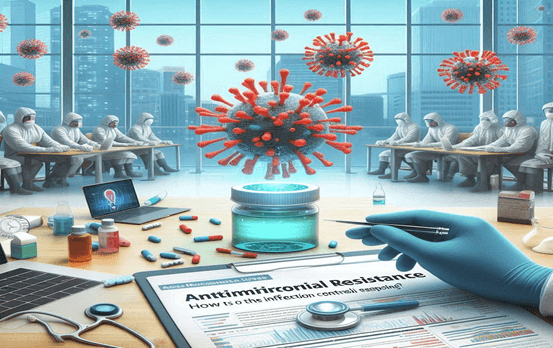Antimicrobial Resistance: How Is the Infection Control Market Responding?
Published Date: 06 Oct 2024
Presently, an emerging global health crisis looms large over the very foundations of modern medicine. What were once trivially treatable infections have now become unmanageably difficult to treat as bacteria, viruses, fungi, and parasites evolve and build resistance to the drugs designed for their elimination. The World Health Organization puts Antimicrobial resistance (AMR) in the list of the top 10 global public health threats, saying we will face a future where minor infections or routine surgeries become life-threatening for most of us, unless we act immediately. The consequences of AMR are shocking. Already, the estimated incidence of drug-resistant infections across the world results in around 700,000 deaths annually; this figure is expected to rise to 10 million in 2050 should current trends persist. The monetary cost of AMR is equally dreadful from extended stays in the hospital, more extensive care, and the preparation of new treatments. This is generally due to the overuse and misuse of antibiotics in healthcare, agriculture, and other related fields. Bad infection control measures, poor sanitation, and the slow rate of newly developed antimicrobials worsened the situation. With this scenario, there is an urgent need for innovation in infection prevention and control with a critical trend in the spread of resistant pathogens. The infection control market, including the companies working on products like disinfectants, sterilization technologies, antimicrobial coatings, and diagnostic tools, is perceived to have an important strategic role in the war against AMR.

The infection control market has a particularly important role: Prevention measures through infection control might be the only viable approach to slowing down the spread of resistant organisms. As a result, the increasing demand for products and services that could limit infections within healthcare and public spaces has triggered high demand for infection control in the market.
1. Sterilization Technologies: New equipment sterilization technologies like UV disinfection systems and hydrogen peroxide vapor systems, among others, are essential in providing decontamination of diverse medical environments.
2. Antimicrobial Surfaces and Coatings: Hospital wards and clinics, along with public places of high turnover, are being treated with coatings that kill bacteria on contact with the surface, thereby reducing the chance of transmission from dirty surfaces.
3. Advanced Diagnostic Tools: Rapid diagnostic tests are being developed for the rapid detection of resistant organisms to target the treatment against the resistance while avoiding its non-essential use.
4. Hand hygiene and PPE: All hand sanitizers, hand soaps, and all PPE, including gloves and masks, have risen in the marketplace. Innovations in this area ensure that such products are much more effective in eradicating or curbing further spread of pathogens.
Market Growth and Trends: Due to the increased cases of hospital-acquired infections, particularly those by multidrug-resistant organisms, the infection control market has continued growing.
1. Rise in the Demand for Disinfectants: There is a wide demand for the disinfectant products and especially alcohol-based formulas. This is particularly so in health facilities. Companies should, besides this, focus on environmentally friendly disinfectants for further reduction of the adverse impacts of human beings on ecosystems.
2. Sterilization Technologies: The companies are investing in new sterilization technologies, which include plasma-based sterilizers and low-temperature sterilizers. These sterilize sensitive medical devices and instruments effectively and do not damage them.
3. Advancement Trends of Antimicrobial Textiles: Antimicrobial fabrics have an enormously high usage in bed linen, clothing, and curtains in hospitals as well as health care centers. This surely restricts the spread of pathogens in the high contact zones.4. AI and data analytics for infection control: used to predict outbreaks of infection, areas of spread of infection, and effectiveness of control measures
Barriers and Obstacles:
Implementation Cost: Many advanced infections control technologies are very costly, thereby making implementations cumbersome for less funded healthcare systems, especially in low- and middle-income countries.
Variability across countries' standards: the infection control practices vary from one country to another, which makes it hard to enforce the implementation of international measures in the same natural way. The low standardization makes it easier for resistant organisms to spread across borders.
Overuse of disinfectants: While disinfectants play an important role in fighting infections, their overuse also leads to the emergence of resistant strains. There exists a tenuous boundary between infection control and finding ways to promote the emergence of resistant microbes.
The Future of Infection Control in the Age of AMR:
To stand in contest against AMR, the latter calls for a shift in practice in infection control at a steady pace. It will call for continued investment in research and development, innovation of novel diagnostic tools, and uptake of advanced technologies such as AI and machine learning that are very potent in ascertaining and preventing the spread of infections. Global cooperation is also essential in managing AMR. This is because practices in systems of health care all around the world will have to be similar, share data on resistant organisms, and invest in training the healthcare personnel on best practices in infection control.
Conclusion:
In any case, innovation and adaptation seem to be two sides of the same coin as the infection control market responds to the rise in antimicrobial resistance. However, further investments in research, public health policies, and collaboration among healthcare providers, governments, and private companies would be needed to salvage the effectiveness of the currently available as well as future antibiotics in slowing down resistant organisms from spreading in such a vital and efficient fight against AMR. In total, infection control is moving along the path toward a future that could be free of the threat of resistance to antimicrobials, but sustainable global actions are needed to avoid leaving to future generations a world in which many infections threaten to be uncontrollable.
Maximize your value and knowledge with our 5 Reports-in-1 Bundle - over 40% off!
Our analysts are ready to help you immediately.
